

Date: 2/03/2021
Author: Kent Moors, Ph.D.
On occasion, “Spy Tales” will discuss some rather complicated and involved episodes such as the one I am describing today.
By the time this installment occurred (late 1995), my professional career was well into a personalized version of a Venn Diagram. You know, those circles where the object of interest lies in the area where they all intersect.
For me, life by this point gravitated about three careers: a professorial “day job” at an Eastern US university; a rising recognition as a global energy specialist resulting in the opening of my own consultancy; and a continuing parallel existence in the world of intelligence.
I would still lecture at academic and research institutions outside the country, while the combination of academic scholarship and international energy advising would allow me access to just about any place on earth.
In short, when it came to the “third circle,” I was well positioned for maximum flexibility.
Yet today’s story also involves one of my few intel episodes resulting from something that happened inside the US. Normally, the Agency was not supposed to ply its trade internally. There were exceptions, of course, usually addressing the domestic side of what were primarily foreign targets. Nonetheless, the impact occasionally resonated closer to home.
This is one of them.
We begin (as usual) with some background. Hang on, this is going to be a wild ride.
On the commercial (i.e., overt, non-intel) side, I had previously taken several contracts from a financial forensics firm specializing in tracking money. Today, this would be a staple of counterterrorism. But back in the mid-1990s, the objective was usually something else.
It was (and for that matter still is) called greenmail – the use of money in a kind of corporate blackmail.
A publicly traded company would find itself under a hostile takeover threat. An unsolicited bid for the company’s traded stock would emerge and intensify, forcing management also to acquire available shares. A bidding war would result with the company required to buy up its own equity from third parties to stave off an unwanted acquisition.
In many cases, the intention from the outside was not to acquire the company at all, but to make a profit by increasing the stock price. Here is a hypothetical (and simple) example of greenmail.
Company XYZ has stock selling for $10 a share. A hostile bid emerges offering $15 and begins acquiring a larger stock position. The company responds by offering $20, followed by the bidder offering $30, the company responding with $40, the bidder counteroffering $50, the company buying at $60, and so on.
At each level, the outsider is adding to its portfolio in XYZ stock. At some point, the bidder says, “Too rich for my blood,” sells its shares back to the company at the now inflated price and pockets a very nice windfall.
Today, companies have introduced complicated internal “poison pill” provisions to make greenmail unprofitable. But back at the end of last century, the use of a corporation’s money against itself was becoming a popular way to churn a profit.
This was also used in other markets. My previous work with the financial forensic specialists had involved identifying parties in money transfers used to jack up oil futures contract prices. These were happening from outside the US (the practice was technically illegal in the States) and was becoming a recurring problem. In addition to hiking costs to traders setting the contract prices, it was also increasing the market price of the resulting crude oil.
When the forensic accounting guys came to me this time, the playing field had become larger and far more intriguing.
The Kremlin had contacted the firm for two interrelated reasons. The first was to locate where capital moving out of Russia was ending up. The second was to try and figure out how unknown European-based entities were picking up chunks of important Russian companies. The belief was that money leaving the company was coming back as expat investment. What concerned Moscow, however, was that the external investment was increasingly moving into national security related domestic companies.
I was being contacted strictly as a subcontractor to the firm, not to Moscow. However, the firm’s client was a foreign government (and Russia at that) and my work would in some way pass through to them. That triggered strict counterintelligence directives requiring that I receive the OK from “mother.” CI also happened to be the division in which I did my intel work, and its operating instructions took a very jaundiced view of any of us serving as an advisor to another government unless the agency gave formal approval before the advisory began and oversaw the assignment.
Well, given that this included who was picking up shares in some choice Russian aeronautical and military-related companies, the agency quickly approved (and even gave me an operating budget).
At the time, the precarious financial conditions inside Russia had led to a hemorrhaging flow of money out of the country. Much of this would use already existing trade routes. That is, export agreements for, say, oil or aluminum or timber would be artificially enhanced to allow in kind transfers of assets out.
Now I had traced some of these transfers previously, especially using crude oil and natural gas leaving Russia and emerging on the books of Swiss trading companies. As early as 1992, my consultancy staff had identified a particular conduit.
Cyprus.
To effect foreign trade between a largely unexchanged currency (the ruble) and hard currency (dollars in the case of oil or gas), the transaction required foreign banks that could deal in both. It may be a commodity moving out of Russia, but it was still valued in rubles (since all internal costs were denominated in the local currency). In fact, the differential between a discounted currency and hard dollars provided the major profit spread once the commodity reached foreign markets.
As I noted in an earlier Spy Tales (“Watching Ships in the Aegean,” December 30, 2020), I had some familiarity with the underbelly of external Russian banking. Over a period of several years, we had identified hundreds of private Russian banks, some operating in the capital of Nicosia but most found in the Cypriot port of Limassol. Almost all of them were shadowy operations essentially there to launder money.
And Russia had plenty of that to give them.
I had attended several meetings of private bankers and financiers on Cyprus. Much of the out-of-sight finance activities underway was either initiated by Russian sources or facilitated by them. That much was well-known. However, what had been occurring more recently with this money flow was very different.
Cyprus had been recognized as a primary Russian money laundering venue for some time. Traditionally, such capital moves occur on behalf of private Russian holdings through correspondent accounts elsewhere, usually employing one of the main international banks on the island.
The depth of these transfers became known much later. A combination of the Cypriot financial crisis in 2013 and later US moves to pressure Russian usage of the Cypriot banking network changed that.
But back in 1995, the situation had taken an unusually dangerous turn, as I will describe shortly.
First, the obligatory background.
The government of Cyprus is housed in Nicosia. That capital has sovereignty over the entire island, although beginning in 1974 the northern one-third has been under the self-proclaimed Turkish Republic of Northern Cyprus (TRNC). Only Turkey across the Mediterranean directly to the north recognizes the Turkish Cypriot enclave.
But the tensions have remained and are occasionally felt in the capital. Nicosia sits close upon the de facto partition with a UN Peace Keeping Force serving as a buffer zone across much of the border.
There are considerable natural gas reserves emerging offshore and the palpable reason for my visits. The TRNC has threatened to obstruct their development.
However, another energy-related Russian money matter surfaced. This one indicated how sophisticated the Russian money path had become. It also testified to the vulnerability of the global oil trading market.
Situated on the southern coast and a center for tourism, the city of Limassol became the locus of Russian money interests in Cyprus.
In a less than four-block area surrounding the street below in Limassol, we estimated at least 212 Russian “banks” were registered, documented as private or merchant. Most had no staff and used as legal addresses the law firms overseeing their paperwork. At one of them, a single closet-sized vacant room on the second floor above a law firm served as the mailing address for 49 of these.
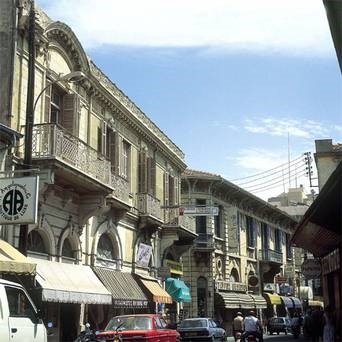

But the amount of funds moving through these shells was rapidly increasing.
Estimates had put the total of Russian funds in Cypriot banks at anywhere between $15 and $25 billion. But such figures usually calculated only those amounts that can be documented as ether deposited in overt accounts at larger banks or local business investments. Aggregate Russian shadow banking was easily many times the “official” total. And most of that traffic was moving through financial conduits housed in Limassol.
While Cyprus remained a lynchpin in the flow of Russian money laundered into the international system for any number of reasons, increasing amounts of the remaining still heavy activity morphed into two areas. The first was local real estate where Russian finance even today remains the driving force. Despite there being less than 200,000 calling the city home, there are so many Russians living or listed as property owners in Limassol that locals jokingly refer to it as “Limassolgrad.”
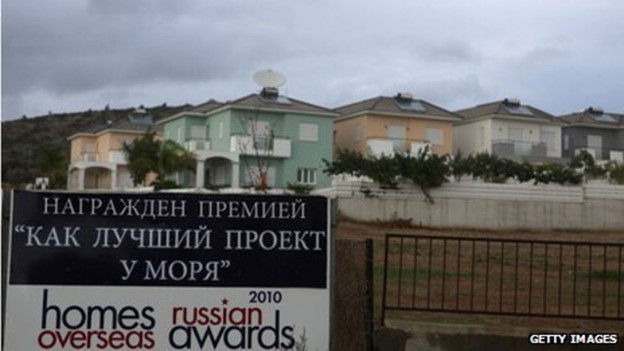

A later Limassol beach front housing development clearly catering to Russians.
The joke has been taken seriously by at least one Russian entrepreneur. The sign below is outside an office in the port claiming to be able to handle all matters for Russians moving themselves or their assts to Cyprus. The company’s name translates Limassolgrad.
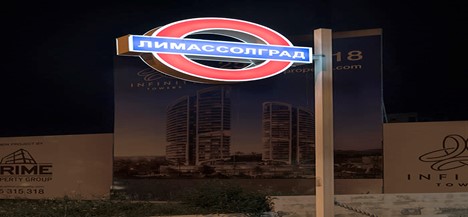

Some of the real estate essentially is used to “park” assets meant as collateral for other ventures, both domestic and foreign. For example, local banking contacts acknowledge that more than half of the units in new high-rise buildings like those pictured below and springing up in the trendy Enaerios area along the water are designed with that purpose.
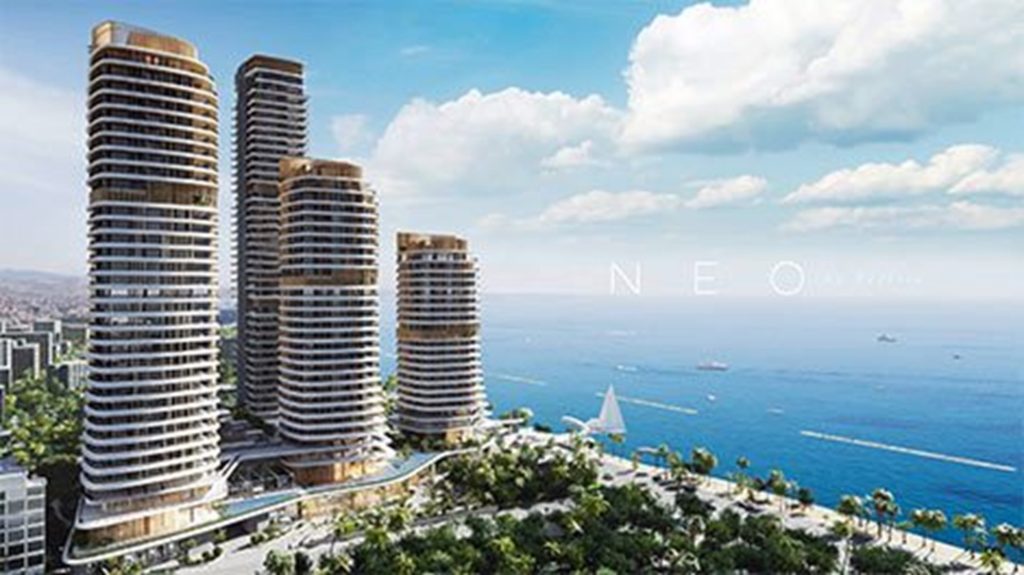

For years, Limassol real estate brokers have been unanimous in the conclusion that the prices are unsustainable, severely disjointing the market. In short, there is little reason to assume the investments were meant to render a profit.
The second target for Russian money involved a far more sophisticated approach. The funds were being used to influence, or in some cases to control, global oil market transactions.
At least a portion of these moves were geopolitical rather than profit-incentive directed. Trading sources in Switzerland, Moscow, London, and the Netherlands confirmed a significant rise of funding traffic into crude oil futures contracts and credit swaps paralleling the swings in oil prices.
Those same market players noted the largest single money source was funding via Cyprus to Swiss and Dutch commodity holding companies, each one of which has either a controlling or significant Russian partner/owner.
I expected, therefore, that my late 1995 assignment would find the money coming out of Russia taking similar paths. Some of that turned out to be true. But a whole new wrinkle appeared that brought the matter into the US.
And led to the death of somebody I knew.
While researching where Russian money was going after it reached Cyprus, something unexpected turned up. At least 148 shell companies (I gave up listing them at a certain point) were found using one of three apartment addresses in San Francisco. Appropriately enough, these were in the Russian Hill district of the city, all on Polk Street.
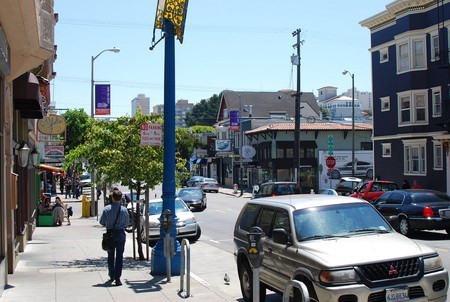

The companies each had an individual residing in either Russia or Ukraine as the titular “president,” had no office nor apparently had conducted any domestic business. They did, however, have one interesting thing in common.
Each was listed as the founding entity for accounts in various Swiss private banks (mostly providing a banking addresses in Zug, but others were also in Zurich, Geneva, Lucerne, Basel, and Stans). Particulars on those accounts were shielded from view by Swiss banking laws, although the fact that an American-based entity “owned” an undesignated account at a Swiss bank was not. That was available from the US side.
Additionally, records of SWIFT transfers from these Swiss houses were also accessible, although not the particular accounts from which they arose.
Disproportionately during the period after these accounts had been established, significant transfers had taken place to brokerage funds in several European Union member countries. Switzerland has never been a member of the EU, but Cyprus would become one in 2004.
In 1995, however, a more circuitous route was necessary. Apparently, US-based shells would be set up to control the disposition of funds in Cyprus that were being transferred to Switzerland to buy stock through EU brokerages. Cyprus had a banking agreement with the US. It did not have one at the time with Switzerland (money, of course, would end there anyway, but the size and frequency of the transactions would have raised red flags for Swiss banking regulators). Switzerland, in turn, had full banking arrangements with EU countries.
Another element seemed to settle the matter. To qualify to use brokerages in Europe, your funds needed to have “residency status.” US citizens cannot qualify, but certain US companies could (and, apparently their Swiss parked greenbacks). The requisite investment accounts were available for the companies located in San Francisco.
An outline of money movement was emerging. Russian money in Cyprus was moving through Swiss accounts controlled by San Francisco firms that were conducting no business. The large transfers went to various investment funds at European brokerage houses and ended up, apparently, buying Russian stocks (among other objects).
But I had no specifics that would settle the matter. It is at this point I made a tragic error.
In mid-November of 1995 I discussed the matter with a contact in San Francisco who was known for doing some heavy lifting in examining dark matters. Ben and I had crossed paths in Vietnam twenty years earlier when we had other responsibilities. He was writing for The Saigon Post, an independent English language newspaper that closed with the fall of the city in 1975. I was there in my first intel operations, assignments “mother” continues to insist are off limits for “Spy Tales.” I am still working on this.
Ben had become an adroit investigator of shady business deals and was an on again off again writer for the most outspoken anti-corruption newspaper in the city.
This was the San Francisco Independent (it ceased publishing in 2005). The paper had uncovered and mercilessly pursued several very high-profile local political controversies. These included some unsavory under the table machinations by companies looking for local contracts or avoidance of legal responsibility. The Independent generated its fair share of adversaries.
Ben was a dogged digger and knew more than a few people you did not want to meet after sundown. The existence of what he immediately began calling “the 148” intrigued him, adding he would nose around and let me know what he found out about the shells companies I had uncovered,
He died on December 5, 1995, the Tuesday after our last conversation. His body was found on a downtown sidewalk below a high rise. The local officials concluded (with some outside prodding from Langley) that it was a suicide.
I found that patently absurd but kept my mouth shut. After all, in a very real sense, I am the one who probably got Ben killed. Over the years, he had ticked off other people in the city. But I never bought the idea that somebody else decided to get even at that particular moment.
My investigation was wrapped up and sent along to close the consulting contract. “The 148” became the target of a US Treasury-FBI-CIA restricted interagency group (called a RIG) on which I served briefly.
Even today, however, the Russian Cyprus money trail remains and has found other objects of interest. That’s what money does…dirty or otherwise.


Dr. Kent Moors
This is an installment of Classified Intelligence Brief, your guide to what’s really happening behind the headlines… and how to profit from it.
Dr. Kent Moors served the United States for 30 years as one of the most highly decorated intelligence operatives alive today (including THREE Presidential commendations). After moving through the inner circles of royalty, oligarchs, billionaires, and the uber-rich, he discovered some of the most important secrets regarding finance, geo-politics, and business. As a result, he built one of the most impressive rolodexes in the world. His insights and network of contacts took him from a Vietnam veteran to becoming one of the globe’s most sought after consultants, with clients including six of the largest energy companies and the United States government.
Now, Dr. Moors is sharing his proprietary research every week… knowledge filtered through his decades as an internationally recognized professor and scholar, intelligence operative, business consultant, investor, and geo-political “troubleshooter.”
This publication is designed to give you an insider’s view of what is really happening on the geo-political stage. You can sign up for FREE to Classified Intelligence Brief and begin receiving insights from Dr. Moors and his team immediately.
Just click here – https://classifiedintelligencebrief.com/






